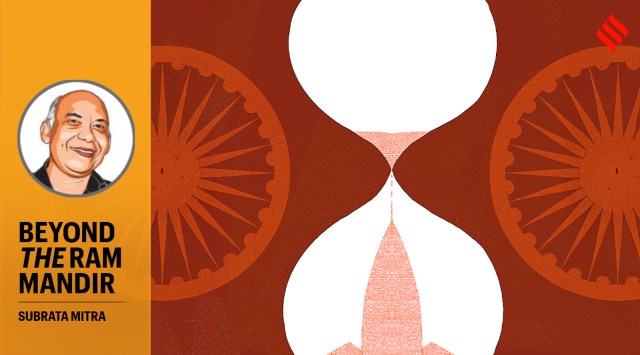
THE inauguration of a Hindu temple and consecration of a deity do not ordinarily make it to global headlines nor do they set alarm bells ringing for many. That the pran pratistha of Ram Lalla on January 22, 2024, did both stands to reason. The Ram temple in Ayodhya is not just a commonplace temple nor is Ram an ordinary member of the vast Hindu pantheon. It is the Ram Mandir built on the sacred ground where as legend has it Lord Ram was born — and where the temple that marked the event was destroyed and a mosque built on the same sacred spot by Islamic invaders. The myth and history are entangled. The violence for repossession of the ground is documented, which has turned it into the predominant focus of Hindu-Muslim conflict in North India.
More than the eminent gathering and official ceremonies, it was the presence of Prime Minister Narendra Modi, not just as part of the distinguished crowd but as the mukhya yajman – the chief patron – appropriately attired as a Hindu devotee and supplicant, seeking the blessings of Lord Ram on behalf of the nation, that signalled the significance of the event. Modi’s words “Dev se desh, Ram se rashtra” (from deity to country, from Ram to nation), the leitmotif of his inaugural address, are deceptive in their simplicity but are open to radically different interpretations.
The blending of Hindu symbolism and India’s “Sovereign Socialist Secular Democratic Republic committed to Justice, Equality and Liberty for the people” gave the impression of the state moving towards a construction from which many, particularly those who subscribe to Abrahamic religions like Islam and Christianity, felt excluded.
In retrospect, the expected electoral bonanza for the BJP in the parliamentary election of 2024, resulting from the deliberate intertwining of Hindu symbols and those of the state, did not happen. The momentum of Hindu mobilisation that was supposed to deliver a resounding victory of over 400 seats to the BJP-led NDA did not materialise. In fact, the BJP candidate — with a string of victories in the past in the Faizabad constituency where the Ram Mandir is located — lost the election. What went wrong?
Speculation in the media sometimes does not take into account the logic of electoral choice. Once the desired objective has been secured, people tend to look out for the next best thing. After the demand for the temple was met, the grim reality of unemployment, apprehensions about the abrogation of reservation for Dalits, and promise of caste quotas appear to have swayed many voters in the North, cutting into the support base of the BJP. To put it bluntly, electorally, Ram could not be sold twice.
A critical perusal of developments in Indian politics during the year since the consecration of the Ram Mandir has some important lessons for observers of the Indian state. They need to stay focused on the significance of two events, demolition of the Babri mosque in 1992 and consecration of the statue of Ram Lalla in the Ram Mandir in 2023, built on the ground which many Hindus hold as sacred. Between the two iconic episodes hangs the tale of the moral foundation of the Indian Republic as we know it, and its long-term sustainability. To treat either event as terminal is infructuous. There is plenty of room to manoeuvre between defeatism resulting from the former and triumphalism and complacency of the latter, for citizens, policy makers and thinkers. In transitional societies, the passage from alien rule to independent statehood creates a pressing need to devise a collective identity that would bolster the state and bind the nation together. Protecting order, and simultaneously shaping collective identity, is the twin challenge that confronts leaders of post-colonial states during the phase of transition. The path towards an enduring solution is studded with potential dangers to the very survival of the state and social integration.
It is but natural that subjects turned citizens should long to see the symbols that they consider sacred in their private lives in the public sphere, and have them woven into public institutions. Ignoring the religiosity of the masses in the name of dharmnirapekshata – a wall of separation between religion and the state – can be just as hazardous as imposing any particular religion on society as a whole. The former can produce a legitimacy deficit, leading to a sense of thwarted agency and disastrous explosions of righteous anger; and the latter can keep the communal pot a-simmer, with the perpetual threat of tensions boiling over, as one can see from the breakup of Pakistan and the ethnic conflict in Sri Lanka.
Recognising the faith of the majority – howsoever diffuse and thinly shared – as primus inter pares, while giving full legitimacy and ensuring basic rights to other belief systems on the lines of European states, might be the best way forward for the country. Especially when it has the world’s largest cohort of the young, an estimated 230 million below the age of 18, a generation whose hope and aspiration can outweigh its burdens of history. What stand the government, therefore, takes on the Places of Worship Act 1991 — will be instructive and telling. Is every structure open to contestation or after the Ram Mandir, is there a need to take a deep breath, a step back? How will this square with sabka saath and sabka vishwas? These questions are not just one party’s. For, to reflect on how the nation can manage this transition in an orderly and democratic manner, without the bloodshed of the English Civil War or the Spanish Reconquista, is a worthwhile challenge for all who are committed to human dignity and respect for the sense of the sacred that lies at the core of all belief systems, at the very heart of our republic.
The writer, Emeritus Professor, Heidelberg University, is the co-editor of Re-use: the Art and Politics of Integration and Anxiety (Sage 2012)